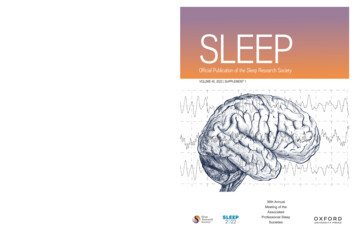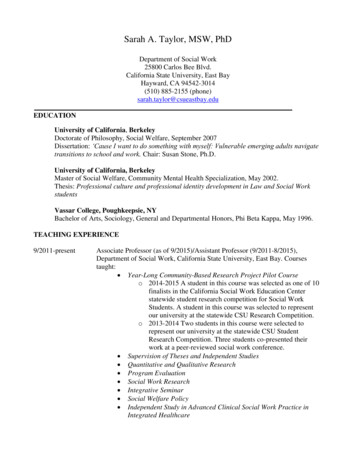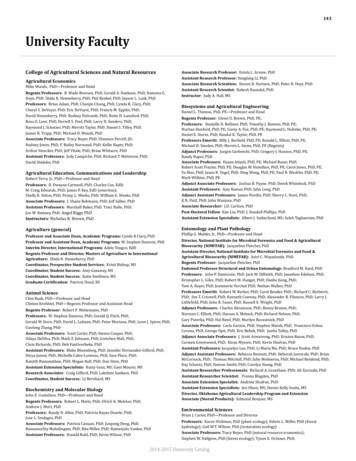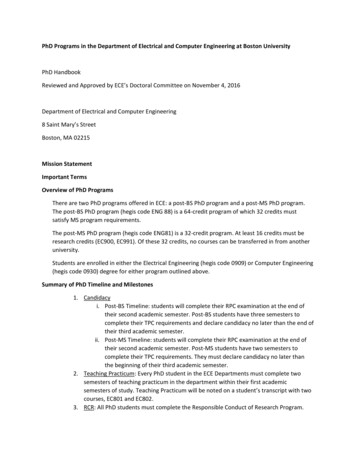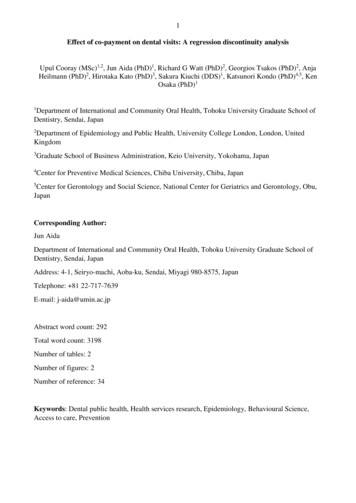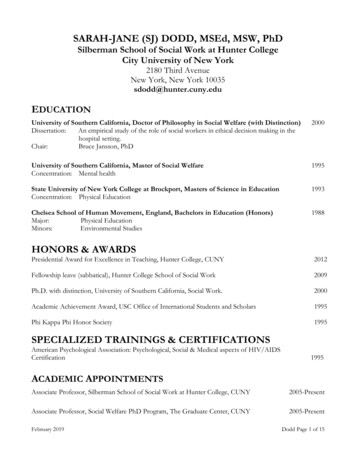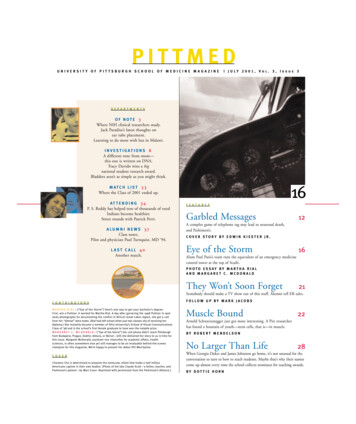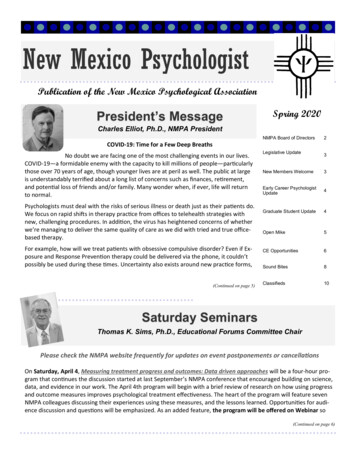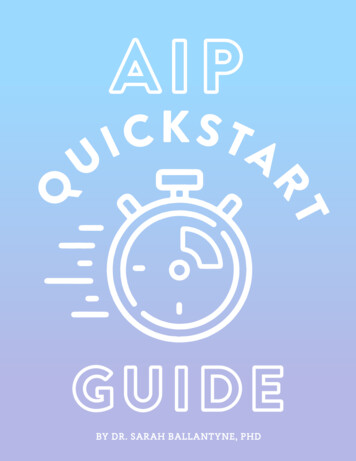
Transcription
QRTUKSTCIABY DR. SARAH BALLANTYNE, PHDA I P Q U I C K S TA R T G U I D E1
AIP QUICKSTARTGUIDE2What Is Autoimmune Disease?3 What to avoid on AIP4What Is the AutoimmuneProtocol?6How Does the AIP Work?8The Science Behind the AIP12 Nutrient Density14 Top Food Sources of EssentialNutrients16 What Do I Eat on the AIP?18 AIP “Yes” Foods19 What Foods Do I Avoid?21 Foods To Avoid22 Constructing an AIP Plate23 Stocking Your AIP Kitchen25 Meal Ideas27 Reintroducing Foods30 AIP Lifestyle33 Troubleshooting34 The Best AIP ResourcesA I P Q U I C K S TA R T G U I D E2
WHAT IS AUTOIMMUNEDISEASE?Autoimmune disease is an epidemic in our society, affecting an estimated 50million Americans. There are more than a hundred confirmed autoimmunediseases—some of the most common being Graves’ disease, Hashimoto’sthyroiditis, lupus, rheumatoid arthritis, multiple sclerosis, Sjögren’ssyndrome, alopecia, psoriasis, ulcerative colitis, Crohn’s disease, and type 1 diabetes—and manymore diseases that are suspected of having autoimmune origins. Although each conditionbrings unique symptoms, the root cause of all autoimmune diseases is the same: our immunesystem, which is supposed to protect us from invading microorganisms, turns against us andattacks our own proteins, cells, and tissues instead. Which proteins, cells, and tissues areattacked determines the specific autoimmune disease and its symptoms. For example, inHashimoto’s thyroiditis, the thyroid gland is attacked. In rheumatoid arthritis, the tissues of thejoints are attacked. In psoriasis, proteins within the layers of skin cells are attacked.Although genetic predisposition accounts for approximately one-third of the risk of developingan autoimmune disease, the other two-thirds comes from diet, lifestyle, and environmentalfactors. In fact, experts are increasingly recognizing that certain dietary factors are key contributors to autoimmune disease, placing these autoimmune conditions in the same class ofdiet- and lifestyle-related diseases as type 2 diabetes, cardiovascular disease, and obesity.That means that in many cases, managing autoimmune disease andpreventing (or at least minimizing) flare-ups is within our power.Because the Paleo diet naturally eliminates a number of autoimmune triggers (including foodsthat cause or aggravate a leaky gut) while including key nutrients that support healthy immuneand hormone function, simply adopting a Paleo diet may lead to noticeable improvements insymptoms. However, a modified form of Paleo called the Paleo Autoimmune Protocol (typicallyA I P Q U I C K S TA R T G U I D E3
abbreviated AIP) takes the therapeutic effects of Paleo even further. The AIP is a powerfulstrategy that uses diet and lifestyle to regulate the immune system, putting an end to theattacks and giving the body the opportunity to heal.A I P Q U I C K S TA R T G U I D E4
WHAT IS THE AUTOIMMUNEPROTOCOL?E ATMEATSEAFOODTONS OFVEGETABLES*FRUITexcept nightshadesHEALTHYFATSD O N’T E ATGRAINSLEGUMESDAIRYPROCESSED &REFINEDFOODSNIGHTSHADESNUTS &SEEDSEGGSALCOHOLThe Autoimmune Protocol, or AIP, is a science-based diet and lifestyle intervention forautoimmune disease. In a recent clinical trial in patients with Inflammatory Bowel Disease,73% of participants were in full clinical remission after following the AIP for only six weeks,and they experienced continued improvement over the entire course of the study.The Autoimmune Protocol is a specialized version of the Paleo diet with an even greater focuson nutrient density and even stricter guidelines for which foods should be eliminated. Theelimination list includes some foods typically allowed on the Paleo diet that have compoundsthat may stimulate the immune system or harm the gut environment, including nightshades(like tomatoes and peppers), eggs, nuts, seeds, and alcohol.The goal of the AIP is to flood the body with nutrients while avoidingany food that might be contributing to disease (or at the very leastinterfering with efforts to heal).A I P Q U I C K S TA R T G U I D E5
It is an elimination diet strategy, cutting out those foods that are most likely to hold back ourhealth. After a time, many of the excluded foods, especially those that have nutritional meritdespite also containing some (but not significant quantities of) potentially detrimental compounds, can be reintroduced systematically.The Autoimmune Protocol is a complementary approach to chronic diseasemanagement focused on providing the body with the nutritional resourcesrequired for immune regulation and tissue healing while removing inflammatory stimuli from both diet and lifestyle. The AIP diet provides balancedand complete nutrition while avoiding processed and refined foods andempty calories. The AIP lifestyle encourages sufficient sleep, stress management and activity asthese are important immune modulators.As is always the case with chronic disease, consult with your physician before beginning this orany other regimen, or altering medications or supplements.A I P Q U I C K S TA R T G U I D E6
HOW DOES THE AIP WORK?The Autoimmune Protocol works by addressing four key areas known to be important contributors to immune and autoimmune diseases. Drawing on insights gleaned from more than 1,200scientific studies, these diet and lifestyle recommendations specifically target: NUTRIENT DENSITY. The immune system (and indeed every system in the body)requires an array of vitamins, minerals, antioxidants, essential fatty acids, and aminoacids to function normally. Micronutrient deficiencies and imbalances are key playersin the development and progression of autoimmune disease. Focusing on consumingthe most nutrient-dense foods available enables a synergistic surplus of micronutrientsto correct both deficiencies and imbalances, thus supporting regulation of the immunesystem, hormone system, and detoxification system and the production of neurotransmitters. A nutrient-dense diet further provides the building blocks that the body needsto heal damaged tissues. GUT HEALTH . Gut dysbiosis and leaky gut are key facilitators in the developmentof autoimmune disease. The foods recommended on the AIP support the growth of bothhealthy levels and a healthy variety of gut microorganisms. Foods that irritate or damage the lining of the gut are avoided, while foods that help restore gut barrier functionand promote healing are endorsed. HORMONE REGULATION. What, when, and how much we eat affect a variety ofhormones that interact with the immune system. When dietary factors (like eating toomuch sugar or grazing rather than eating larger meals spaced farther apart) dysregulatethese hormones, the immune system is directly affected—typically stimulated. The AIPis designed to promote regulation of these hormones, thereby regulating the immunesystem. These and other essential hormones that impact the immune system are alsoprofoundly affected by how much sleep we get, how much time we spend outside, howmuch and what kinds of activity we get, and how well we reduce and manage stress.A I P Q U I C K S TA R T G U I D E7
IMMUNE SYSTEM REGULATION. Immune system regulation is achieved byrestoring a healthy diversity and healthy number of gut microorganisms, restoring gutbarrier function, providing sufficient amounts of micronutrients, and regulating the keyhormones that regulate the immune system.Although scientific research on Paleo and autoimmune disease is still in its infancy, studiesof multiple sclerosis patients have already shown that the AIP has therapeutic potential forthe debilitating autoimmune disease secondary progressing multiple sclerosis, and studies ofCrohn’s disease have shown that full remission occurs in a matter of weeks in the majority ofpatients. And while anecdotal stories cannot be used to validate any dietary approach, the tensof thousands (and counting!) of people who have successfully used variations of the Paleo diet,including the AIP, to mitigate and even completely reverse their diseases is compelling.A I P Q U I C K S TA R T G U I D E8
THE SCIENCE BEHIND THE AIPThe Paleo Approach by Sarah Ballantyne, PhD provides detailed scientific rationaleincluding more than 1,200 citations for every aspect of the Autoimmune Protocol,including why some foods need to be avoided and why it’s important to eat more ofothers, and why it’s important to get more sleep, manage stress, and get the right amounts of theright kinds of activity.Though it’s not essential to understand the science behind the Autoimmune Protocol recommendations in order to implement and benefit from them, many people find motivation in the knowledge that these recommendations have a firm scientific foundation.Here are some of the highlights:NUTRIENT DENSITY A nutrient-poor diet is one of the biggest risk factors for autoimmune disease.Autoimmune diseases have been linked to dietary insufficiencies of a staggeringnumber of vitamins and minerals, as well as to insufficiencies in antioxidants, fiber,and essential fatty acids. The immune system requires micronutrients (water-soluble and fat-soluble vitamins,minerals, and antioxidants), plus essential fatty acids and amino acids, to functionnormally. Some of the nutrients that we’re most likely to be deficient in are the most importantfor immune system regulation, including vitamins A and D, and zinc. Eating fat is good for you. The healthiest fats are saturated and monounsaturated fats(with the caveat that it’s important to limit saturated fat to no more than 15% of totalcalories), and it is essential to consume a balanced ratio of omega-6 to omega-3polyunsaturated fatty acids (ideally between 1:1 and 4:1). Eating fat is necessary for the absorption of fat-soluble vitamins.A I P Q U I C K S TA R T G U I D E9
Eating a nutrient-dense diet based on quality meats, seafood, vegetables, and fruits isthe healthiest and most effective way to ensure that your body is getting all thenutrients it needs for optimal health. Increasing nutrient density can increase your resilience to stress, meaning thatstressors in your life have less of an impact on your well-being, and help regulateimportant hormones and neurotransmitters.GUT HEALTH A leaky gut is necessary for autoimmune disease to develop. A variety of proteins in grains—including prolamins, such as gluten, and agglutinins,such as wheat germ agglutinin—cause increased intestinal permeability (gut leakiness)and feed bacterial overgrowth in the gut. Digestive enzyme inhibitors in grains, legumes, nuts, seeds, and dairy products causeinflammation in the gut and feed bacterial overgrowth in the gut. A high dietary intake of phytates or phytic acid—found in grains, legumes, nuts, andseeds—may increase intestinal inflammation and gut dysbiosis. Types of saponins called glycoalkaloids, found in vegetables of the nightshade family,cause increased intestinal permeability. Other saponins found in legumes may also beproblematic. Alcohol consumption causes increased intestinal permeability, damages the gut, andfeeds bacterial overgrowth and dysbiosis. Excessive fructose intake (more than 40 grams per day) may cause increased intestinalpermeability and damage to the liver. It’s best to aim for 10 to 25 grams daily. All sugar substitutes have negative health effects, and many of them cause increasedintestinal permeability. Too much omega-6 fatty acids cause gut dysbiosis. Increasing omega-3 fatty acid intakehelps correct gut dysbiosis. Too much saturated fat also skews gut bacteria towards unfavorable strains. Aim for10% to 15% total calories from saturated fats.A I P Q U I C K S TA R T G U I D E10
A diet rich in vegetables, including plenty of nonstarchy vegetables and some starchyvegetables, supports a healthy variety and amount of probiotic gut organisms. Aim for8 servings daily. Probiotic-rich foods support a healthy gut microbiome. Foods rich in vitamin A, vitamin D, vitamin K2, and the amino acids glutamine andglycine can help restore gut barrier function. The medium-chain triglycerides in coconut oil may help restore gut barrier function. Reducing and managing stress is critical for gut barrier health and gut microbiomehealth. Living an active lifestyle (but avoiding overtraining) supports a healthy, diverse gutmicrobiome.HORMONE REGULATION High-carbohydrate diets cause insulin resistance and leptin resistance. Following a low-carbohydrate diet is not optimal (it’s nearly impossibleto get enough fiber and phytochemicals on a low-carb diet), but avoiding ahigh-carbohydrate diet is. Regulating blood glucose levels and insulin release by eating low- tomoderate-glycemic-load foods is important. This approach helps regulateinsulin and insulin sensitivity as well as leptin and leptin sensitivity. Fructose causes insulin resistance and leptin resistance. Fructose also doesn’tsuppress ghrelin levels after eating. Dietary fructose should be maintained in the 10- to20-grams-per-day range. Hunger hormones are intricately linked to the immune system. Eating large, balancedmeals that contain protein, fat, and low- to moderate-glycemic-load vegetables andfruits and minimizing snacking is the best way to regulate hunger hormones. Cortisol levels may rise as a result of skipping meals or intermittent fasting andstimulate the immune system. Dietary fiber, especially insoluble fiber, from whole-food sources such as vegetableshelps regulate ghrelin levels and may regulate peristalsis by increasing gastrointestinalmelatonin production.A I P Q U I C K S TA R T G U I D E11
Reducing and managing stress, getting plenty of low- and moderate-intensity activity,and getting adequate sleep help regulate critical hormones.IMMUNE HEALTH The immune system requires a tremendous amount of nutrients to function optimally.Eating a nutrient-dense diet is the best way to supply the immune system with thosenutrients. A variety of proteins in grains—including prolamins, such as gluten, and agglutinins,such as wheat germ agglutinin—stimulate the immune system. Gluten may be an important trigger in all autoimmune diseases. Digestive enzyme inhibitors in grains, legumes, nuts, seeds, and dairy products causeinflammation. Types of saponins called glycoalkaloids, found in vegetables of the nightshade family,significantly stimulate the immune system. Other saponins found in legumes may alsobe problematic. Alcohol consumption stimulates inflammation. Proteins found in egg whites act as carrier molecules for bacterial proteins to cross thegut barrier, which then stimulate the immune system. Excessive fructose intake (more than 40 grams per day) causes inflammation. Eating too much omega-6 fatty acids causes inflammation, whereas increasing omega-3fatty acid intake helps reduce inflammation and modulate the immune system.Moderate consumption of monounsaturated fats and saturated fats is healthy. Reducing and managing stress and getting plenty of sleep are critical for normalimmune function.A I P Q U I C K S TA R T G U I D E12
NUTRIENT DENSIT YMicronutrient deficiency is increasingly showing up as a major underlyingdriver of chronic disease including autoimmune disease. Many of us think thatnutrient deficiencies are mainly a problem in developing nations (whereasin Westernized countries like the United States, our problem is that we have too much food!),but this is a misconception. The Standard American Diet is definitely energy-rich, but it’s alsonutrient-poor: the types of food that many people eat each day are high in added sugars, refined grains, and industrially processed oils, but devoid of the vitamins and minerals (and otherhealth-promoting compounds) found in whole foods. The result is a high prevalence of nutrientdeficiency right in our own backyard.Nutrients are the molecular building blocks of our bodies. Not only arewe made up of these raw materials, but our cells also use nutrients whenthey perform their various functions. This is why we need to continuallyconsume enough nutrients for our cells to stay healthy and keep doingtheir jobs effectively.The term nutrient density refers to the concentration of micronutrients (mainly vitamins andminerals, but the term micronutrients also encompasses phytochemicals, essential fatty acidsand essential amino acids) per calorie of food. High nutrient density foods supply a wide rangeof vitamins and minerals (or alternatively, high levels of a specific, important vitamin or mineral) relative to the calories they contain, whereas low nutrient density foods supply lots ofenergy without much in the way of additional nutrition.A I P Q U I C K S TA R T G U I D E13
Achieving nutrient-sufficiency requires an additional focus on incorporating more of the nutrient powerhouses readily available to us. This means focusing on organ meats, shellfish, brightlypigmented fruit, sea vegetables, fatty fish, cruciferous vegetables, leafy greens, fermented veggies, fresh herbs and fibrous roots whenever possible. Eating 8 or more servings of vegetablesper day is important for nutrient sufficiency!When we consciously opt for the most nutrient-dense foods the majority of the time, we findour whole diet becomes nutrient-dense as a result. The dietary foundation of the AutoimmuneProtocol is the most nutrient-dense foods in the foods supply, including eating copious amountof vegetables, plus fish, shellfish, sea vegetables, organ meat, fruit, healthy fats, and freshherbs.A I P Q U I C K S TA R T G U I D E14
TOP FOOD SOURCES OFESSENTIAL NUTRIENTSA I P Q U I C K S TA R T G U I D E15
A I P Q U I C K S TA R T G U I D E16
WHAT DO I EAT ON THE AIP?MEATSEAFOODTONS OFVEGETABLES*except nightshadesFRUITHEALTHYFATSSome foods are obvious wins for a health-promoting diet because they have tons of beneficialconstituents and very few or no constituents that undermine health—good examples of thesesuperfoods are organ meats, seafood, and most vegetables. Other foods are obvious fails because they have a relative lack of health-promoting constituents and are rife with problematiccompounds—good examples are gluten-containing grains, peanuts, and most soy products. Butmany foods fall into the amorphous world of gray in between these two extremes. Tomatoes,for example, have some exciting nutrients, but they also contain several compounds that are soeffective at stimulating the immune system that they have been investigated for use in vaccinesas adjuvants (the chemicals in vaccines that enhance your immune response to whatever you’regetting immunized against).The biggest difference between a standard Paleo diet and the AutoimmuneProtocol is where we draw the line between “yes” foods and “no” foods inorder to get more health-promoting compounds and fewer detrimentalcompounds in our diet.Those who are typically quite healthy can tolerate less-optimal foods than those who aren’t.You can think of the Autoimmune Protocol as a pickier version of the Paleo diet; it accepts onlythose foods that are clear winners.A I P Q U I C K S TA R T G U I D E17
Following the AIP diet involves increasing your intake of nutrient-dense, health-promoting foodswhile avoiding foods that may be triggers for your disease.IN SUMMARY, THE RULES OF WHAT TO EAT ARE: organ meat and offal (aim for 5 times per week, the more the better)–read more here. fish and shellfish (wild is best, but farmed is fine) (aim for at least 3 times per week, themore the better)–read more here and here. vegetables of all kinds, as much variety as possible and the whole rainbow, aim for 8-14cups per day Green vegetables Colorful vegetables and fruit (red, purple, blue, yellow, orange, white) Cruciferous vegetables (broccoli, cabbage, kale, turnips, arugula, cauliflower, brusselssprouts, watercress, mustard greens, etc.) Sea vegetables (excluding algae like chlorella and spirulina which are immune stimulators) Edible Fungi, like mushrooms herbs and spices quality meats (grass-fed, pasture-raised, wild as much as possible) (poultry in moderationdue to high omega-6 content unless you are eating a ton of fish) quality fats (pasture-raised/grass-fed animal fats [rendered or as part of your meat], fattyfish, olive, avocado, coconut, palm [not palm kernel]) fruit (keeping fructose intake between 10g and 40g daily-note that 20g is probably optimal) probiotic/fermented foods (fermented vegetables or fruit, kombucha, water kefir, coconutmilk kefir, coconut milk yogurt, supplements)–read about them here and here. glycine-rich foods (anything with connective tissue, joints or skin, organ meat, and bonebroth) Source the best-quality ingredients you can. Eat as much variety as possible.A I P Q U I C K S TA R T G U I D E18
AIP “YES” FOODSA I P Q U I C K S TA R T G U I D E19
WHAT FOODS DO I AVOID?The first dietary recommendation for those with autoimmune disease is to adhere to a strictPaleo diet with no cheating. To be clear, this means: no grains, no legumes, no dairy, no refinedsugars, no modern vegetable oils, and no processed food chemicals. While other people may beable to enjoy the occasional bowl of rice or corn chips or even ice cream, if you suffer from anautoimmune condition, you are most likely not one of these people. Gluten-containing grainsshould be banned for life. Other grains and legumes can be very problematic for those with autoimmune conditions. Dairy of any kind (even grass-fed ghee which can still have trace lactoseand dairy proteins!) should be avoided initially. This may be true for the rest of your life butsome people may be able to reintroduce many foods after their diseases are in remission.If you have an autoimmune condition, other foods can be triggers. These foods are also omittedfrom the Autoimmune Protocol because they cause gut irritation, cause gut dysbiosis, act as carrier molecules across the gut barrier, stimulate the immune system, increase gut permeability,and/or cause inflammation. In addition, it’s important to ensure that your blood sugar levels arewell managed. This does not mean low carb. It just means not high carb.A I P Q U I C K S TA R T G U I D E20
REMOVE THE FOLLOWING FROM YOUR DIET: Grains Legumes Dairy Refined and processed sugars and oils Eggs (especially the whites) Nuts Seeds (including cocoa, coffee and seed-based spices) Nightshades (potatoes [sweet potatoes are fine], tomatoes, eggplants, sweet and hotpeppers, cayenne, red pepper, tomatillos, goji berries etc. and spices derived from peppers, including paprika) Potential Gluten Cross-Reactive Foods (corn, dairy, instant coffee, milk chocolate, millet,oats, potatoes, rice, soy, brewer’s and baker’s yeast) Alcohol NSAIDS (like aspirin or ibuprofen) Non-nutritive sweeteners (yes, all of them, even stevia) Emulsifiers, thickeners, food dyes, processed food chemicals, and other food additivesA I P Q U I C K S TA R T G U I D E21
FOODS TO AVOIDPALEO AIP “NO” FOODSALCOHOLBeer, wine (okay for cooking), spiritsEGGSCOFFEEExcept for perhapsan occasional cupGRAINSBarley, corn, durum, fonio, Job’s tears,kamut, millet, oats, rice, rye, sorghum,spelt, teff, triticale, wheat (all varieties,including einkorn and semolina), wild riceGRAINLIKE SEEDSAmaranth, buckwheat, chia, quinoaDAIRYButter, buttermilk, butter oil, cheese,cottage cheese, cream, curds, dairyprotein isolates, ghee, heavy cream, icecream, kefir, milk, sour cream, whey,whey-protein isolate, whipping cream,yogurtLEGUMESAdzuki beans, black beans, blackeyed peas, butter beans, calico beans,cannellini beans, chickpeas (garbanzobeans), fava beans (broad beans), greatNorthern beans, green beans, Italianbeans, kidney beans, lentils, lima beans,mung beans, navy beans, peanuts,peas, pinto beans, runner beans, splitpeas, soybeans (including edamame,tofu, tempeh, other soy products, andsoy isolates, such as soy lecithin)A I P Q U I C K S TA R T G U I D EPROCESSED VEGETABLE OILSCanola oil (rapeseed oil), corn oil,cottonseed oil, palm kernel oil,peanut oil, safflower oil, soybean oilsunflower oilPROCESSED FOOD CHEMICALS& INGREDIENTSAcrylamides, artificial food color,artificial and natural flavors, autolyzedprotein, brominated vegetable oil,emulsifiers (carrageenan, cellulosegum, guar gum, lecithin, xanthangum), hydrolyzed vegetable protein,monosodium glutamate, nitrates ornitrites (naturally occurring are okay),olestra, phosphoric acid, propyleneglycol, textured vegetable protein,trans fats (partially hydrogenatedvegetable oil, hydrogenated oil), yeastextract, any ingredient with a chemicalname that you don’t recognizePROBLEMATIC SUGARS& SWEETENERSAgave, agave nectar, barley malt,barley malt syrup, brown rice syrup,brown sugar, cane crystals, cane sugar(refined), caramel, corn sweetener,corn syrup, corn syrup solids,crystalline fructose, dehydratedcane juice, demerara sugar, dextrin,dextrose, diastatic malt, evaporatedcane juice, fructose, fruit juice, fruitjuice concentrate, galactose, glucose,glucose solids, golden syrup, highfructose corn syrup, invert sugar, inulin,lactose, malt syrup, maltodextrin,maltose, monk fruit (luo han guo),panela, panocha, refined sugar, ricebran syrup, rice syrup, sorghum syrup,sucrose (saccharose), syrup, treacle,turbinado sugar, yacon syrupSUGAR SUBSTITUTESAcesulfame potassium (acesulfameK), aspartame, erythritol, mannitol,neotame, saccharin, sorbitol, stevia,sucralose, xylitolNUTS & SEEDSAlmonds, Brazil nuts, cashews,chestnuts, flax seeds, hazelnuts,hemp seeds, macadamia nuts, pecans,pine nuts, pistachios, poppy seeds,pumpkin seeds, sesame seeds,sunflower seeds, walnuts, any flours,butters, oils, or other products derivedfrom nuts or seedsNIGHTSHADES & SPICESDERIVED FROM NIGHTSHADESAshwagandha, bell peppers (sweetpeppers), cayenne peppers, capegooseberries (ground cherries, notto be confused with regular cherries,which are okay), eggplant, gardenhuckleberries (not to be confused withregular huckleberries, which are okay),goji berries (wolfberries), hot peppers(chili peppers and chili-based spices),naranjillas, paprika, pepinos, pimentos,potatoes (sweet potatoes are okay),tamarillos, tomatillos, tomatoes(Note: Some curry powders containnightshade ingredients.)SPICES DERIVED FROM SEEDSAnise, annatto, black caraway(Russian caraway, black cumin), celeryseed, coriander, cumin, dill, fennel,fenugreek, mustard, nutmeg22
CONSTRUCTING AN AIP PL ATECONSTRUCTING AN AIP PLATEA I P Q U I C K S TA R T G U I D E23
STOCKING YOUR AIP KITCHENFROZEN INGREDIENTS Broth Meat: ground beef, chicken Fish and shellfish: salmon,tilapia, shrimp Vegetables: artichokehearts, broccoli, carrots,cauliflower, celery, onions Fruit: bananas, berries,mangoes, pineappleFROZEN PREPAREDFOODS: soups, stews,casseroles, cookedmeat dishes Fresh herbs: basil, dill,mint, oregano, rosemary,tarragon, thyme (to bestretain the flavors of freshherbs, chop and mix witholive oil before freezing)Avoid freezing salads,delicate herbs, and hotfoods that have not beencooled. The best containersfor freezing are freezer-safeglass containers with tightfitting lids, plastic freezerbags, and plastic liddedcontainers.FRESH OR THAWED MEAT &SEAFOOD: bacon, ground beef,pork shoulder,salmon filletsSome pantry itemsrequire refrigerationafter opening. For longterm storage of alliums,roots, and fruit, putthem in the fridge.OPEN PANTRY ITEMS:coconut aminos, fishsauce, olives, rawvinegarsCOLD BEVERAGES:iced herbal tea,kombucha, mineralwaterFRESH PRODUCE:berries,carrots, celery,cucumbers, kale,lemons, lettuceA I P Q U I C K S TA R T G U I D Ethe healing kitchen24
FROZEN INGREDIENTS Broth Meat: ground beef, chicken Fish and shellfish: salmon,tilapia, shrimp Vegetables: artichokehearts, broccoli, carrots,cauliflower, celery, onions Fruit: bananas, berries,mangoes, pineappleFROZEN PREPAREDFOODS: soups, stews,casseroles, cookedmeat dishes Fresh herbs: basil, dill,mint, oregano, rosemary,tarragon, thyme (to bestretain the flavors of freshherbs, chop and mix witholive oil before freezing)Avoid freezing salads,delicate herbs, and hotfoods that have not beencooled. The best containersfor freezing are freezer-safeglass containers with tightfitting lids, plastic freezerbags, and plastic liddedcontainers.FRESH OR THAWED MEAT &SEAFOOD: bacon, ground beef,pork shoulder,salmon filletsSome pantry itemsrequire refrigerationafter opening. For longterm storage of alliums,roots, and fruit, putthem in the fridge.OPEN PANTRY ITEMS:coconut aminos, fishsauce, olives, rawvinegarsCOLD BEVERAGES:iced herbal tea,kombucha, mineralwaterFRESH PRODUCE:berries,carrots, celery,cucumbers, kale,lemons, lettucethe healing kitchenA I P Q U I C K S TA R T G U I D E25
MEAL IDEASBREAKFAST.Think of breakfast as including a protein, like meat, and some veggies and/or fruit. Your protein could come from bacon, sausage, or even steak or a pork chop! Leftovermeat from last night’s dinner makes for a very quick breakfast. Your sides could include anyfresh fruit. Vegetables can be raw (like mixed greens, or carrots and celery sticks), sautéed (agreat pairing for bacon) or steamed, fermented (homemade or raw sauerkraut makes a greataccompaniment to sausage) or leftovers of any kind. Many root vegetables make for deliciousbreakfast hash.Soup also makes for a very satisfying breakfast. Smoothies can be made with veggies, fruit, coconut milk, and Paleo-friendly protein powder like beef isolate or beef plasma protein. If you’rereally missing breakfast staples, try making Plantain Pancakes.LUNCH. Just like breakfast, think of lunch as including some animal foods and some plantfoods. Lunch can look very much like supper with some kind of protein and some kind of vegetable side dish or dishes. Or lunch could be a salad that includes some leftover chicken or steak orpre-cooked shrimp. Soups and stews make for a quick lunch as do reheated leftovers. If you’rereally used to sandwiches, you could make them with lettuce or nori wraps instead. Looking forsomething really easy to eat on the go? Try jerky with some raw veggies and guacamole andsome fruit or sweet potato chips.DINNER. Dinner ma
The Paleo Approach by Sarah Ballantyne, PhD provides detailed scientific rationale including more than 1,200 citations for every aspect of the Autoimmune Protocol, including why some foods need to be avoided and why it's important to eat more of others, and why it's important to get more sleep, manage stress, and get the right amounts of the
